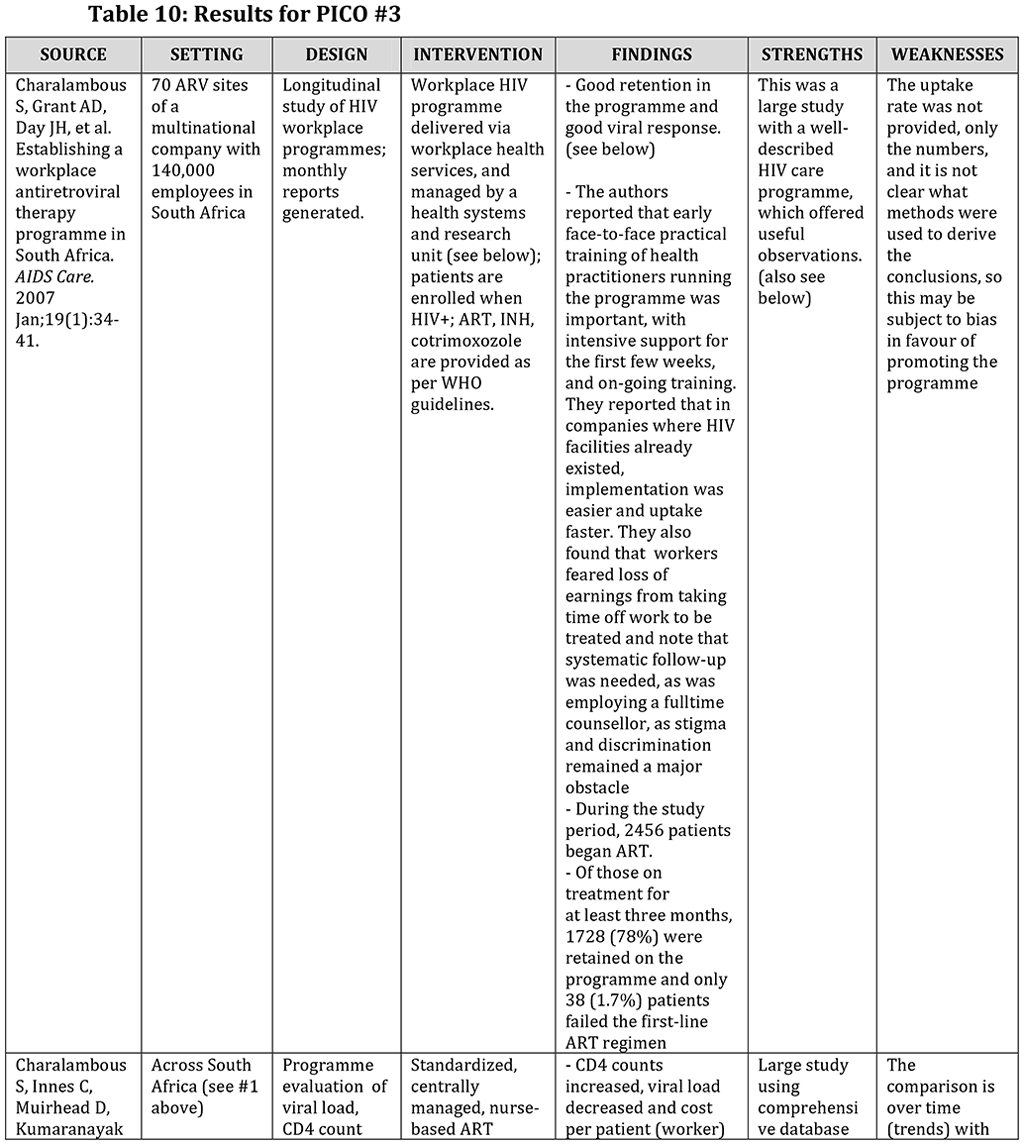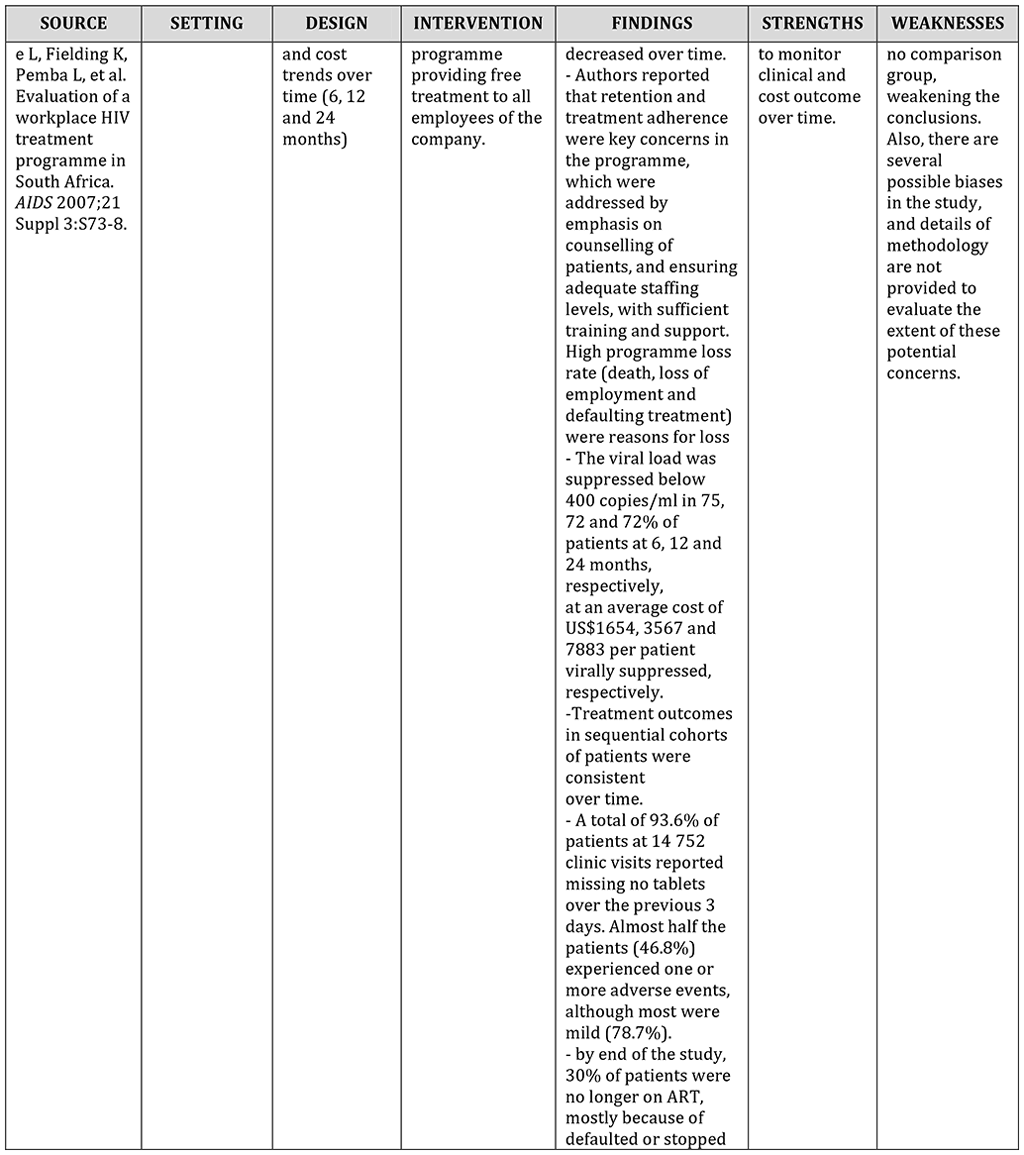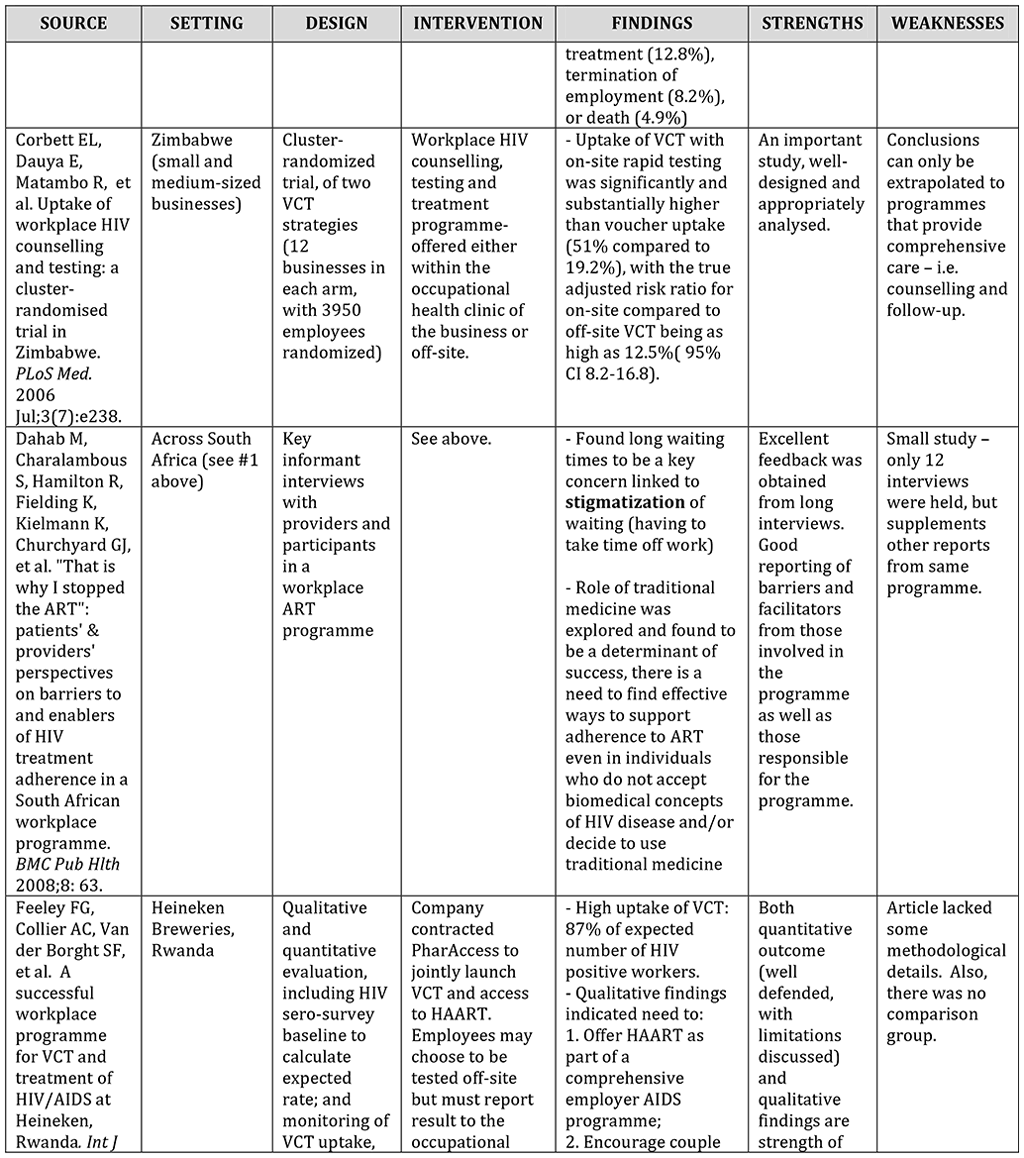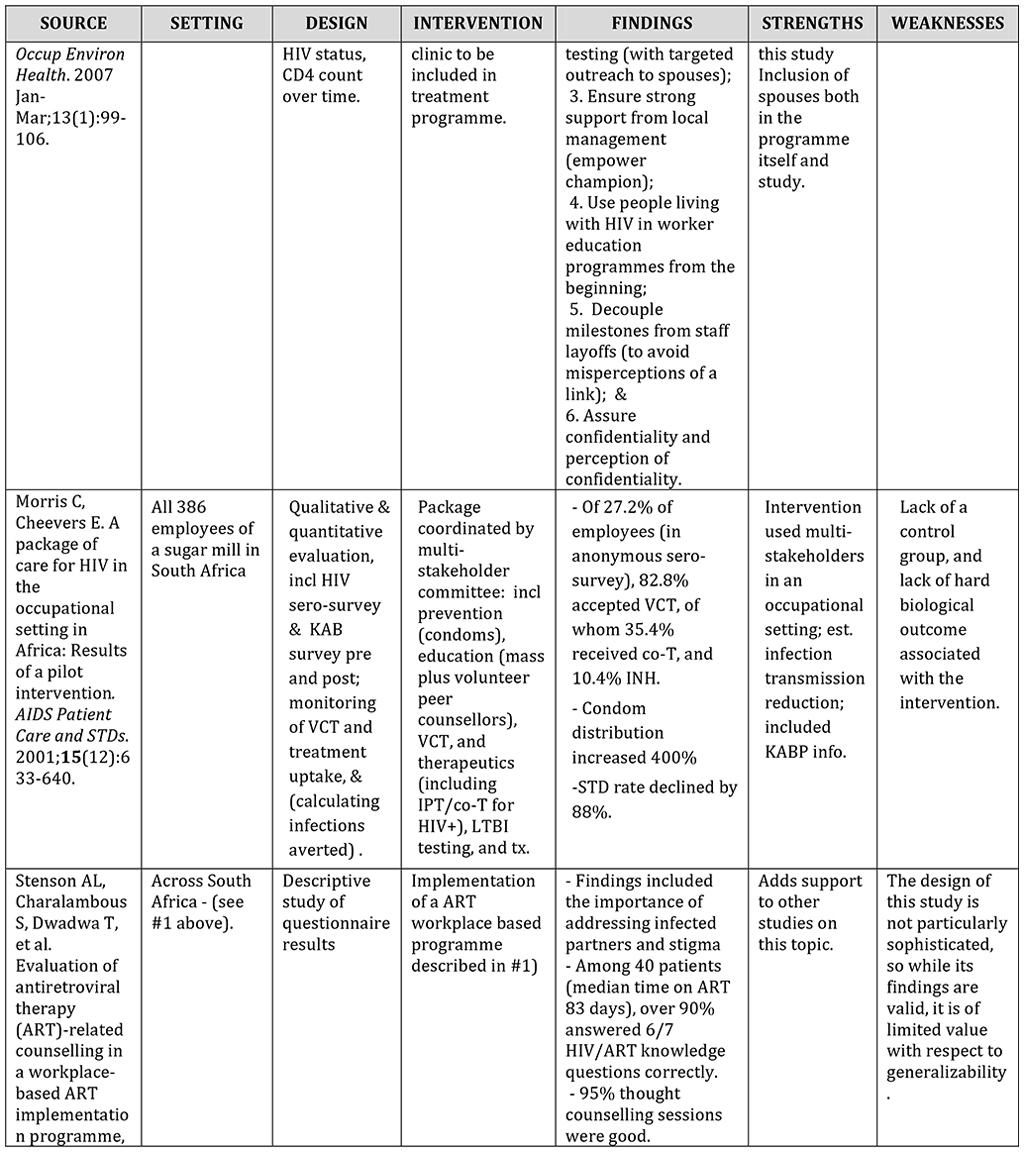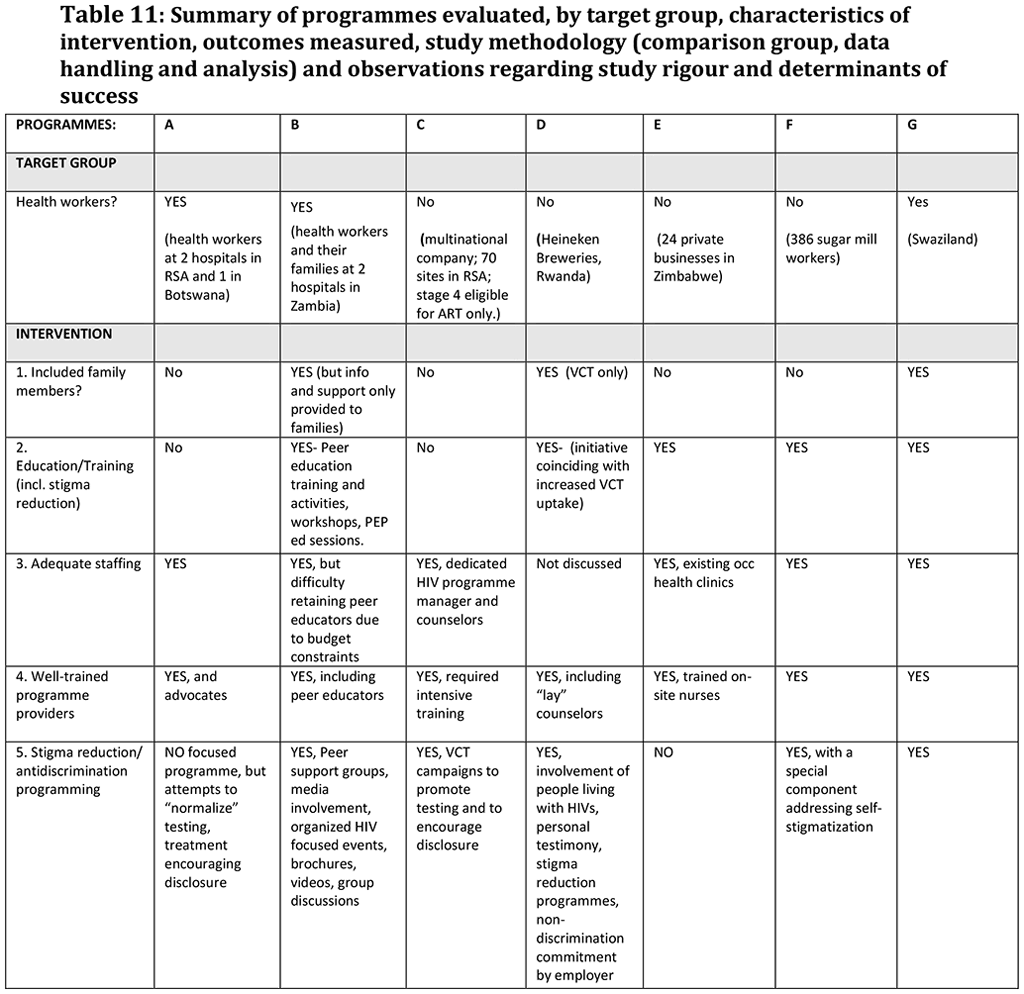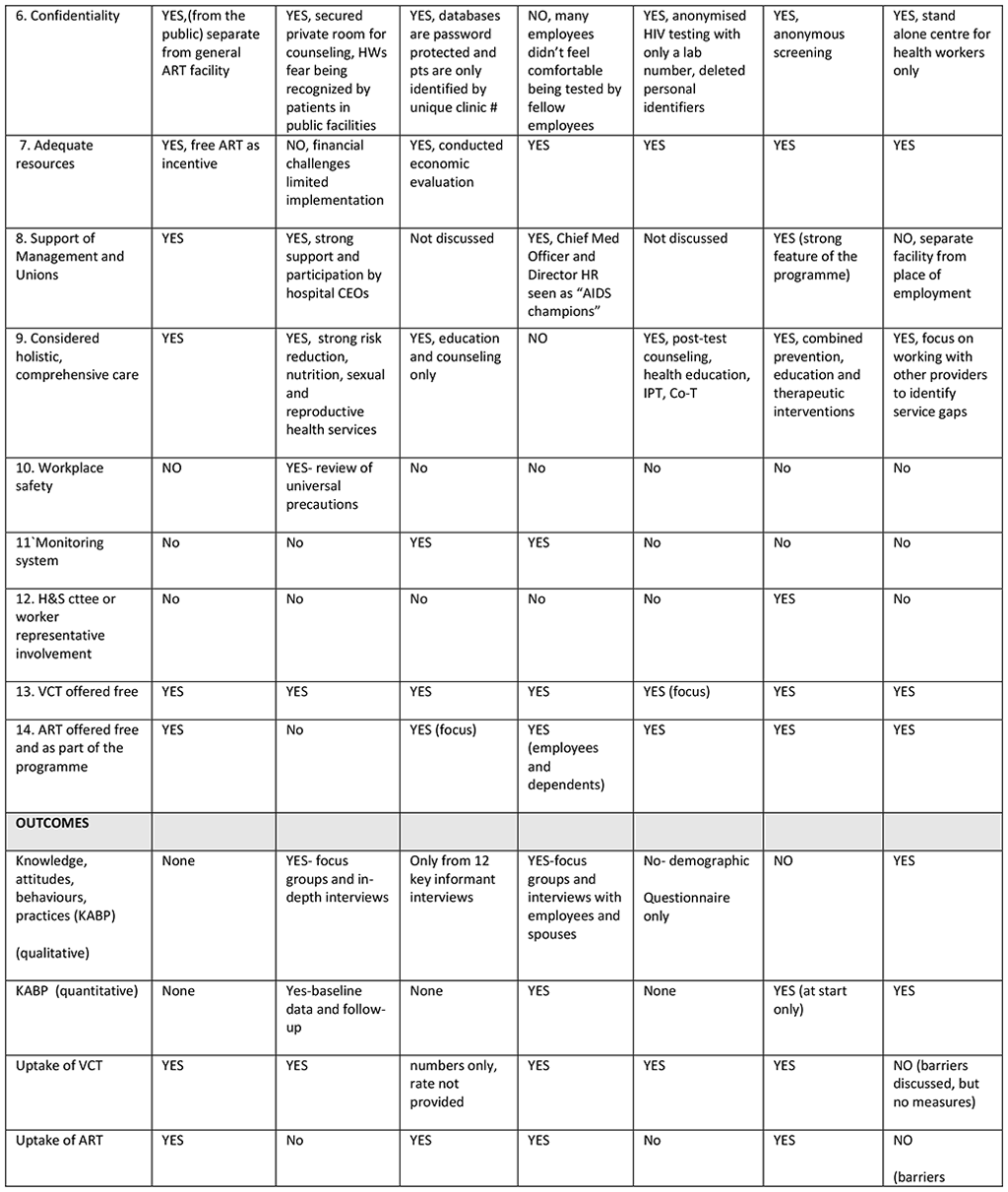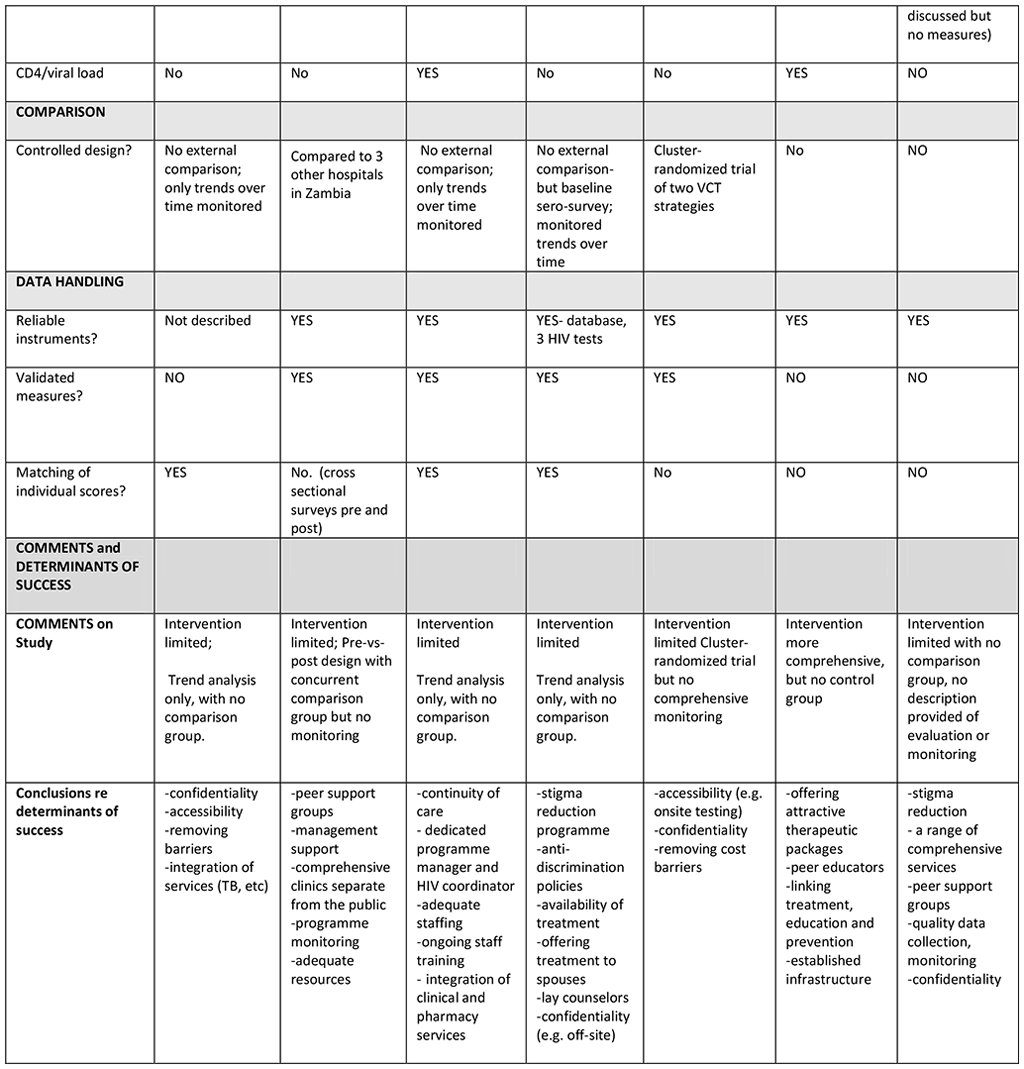Book traversal links for 2.8.1 Adapt and implement good practices in occupational health and the management of HIV and TB in the workplace from all sectors.
In 1999, Michael K conducted a survey of 14 large companies in South Africa in an effort to document the best practices of managing HIV in the workplace. The results indicated that companies conceptualize HIV as either a health or poverty issue and that the effects of AIDS on the workplace environment takes second priority to economic downturns, labour action or inflation. However, a study by Campbell et al. also published in 1999, using case studies and key informant interviews to assess novel approaches to HIV prevention programmes in a South African mining company, found that interventions must be holistic and include trade union representatives as well as a wide range of other stakeholders. Campbell also stresses that the broader contextual factors such as socioeconomic factors that lead to HIV transmission must be considered as opposed to simply biomedical indicators. This is a model concept occurring in private industry that should also be adopted for healthcare worker occupational health programme that deal with management of HIV and TB.
Morris and Cheevers (2001) focused on the dire situation in KwaZulu-Natal, South Africa, employing the occupational health setting to provide an intervention with prevention, education and treatment components. A multidisciplinary committee composed of stakeholders in the occupational health environment including unions, management, medical researchers, and medical personnel was organized to coordinate a combined prevention-care initiative. They calculated that the programme averted 11 HIV infections in a single year of the programme in this sugar mill with 386 workers (a calculated 91.7% decrease in HIV infection), and concluded that providing a package of care for HIV provided through occupational health clinics is well supported.
A noteworthy study by Rosen and colleagues (2004) conducted in South Africa and Botswana aimed to estimate the costs of HIV to the private sector in an effort to demonstrate the value of prevention and treatment options to businesses. Detailed human resource, financial, medical data, and anonymous HIV seroprevalence surveys were analyzed. Results indicated that HIV amongst employees added 0.4-5.9% to the companies' annual salary and wage bills and that the "present value" cost of an incident HIV infection ranged from 0.5 to 3.6 times the annual salary of the affected worker, highlighting the great potential benefit of prevention in purely economic terms. The authors concluded that additional focus and research on the effectiveness of workplace AIDS interventions are urgently needed. This study is particularly relevant to this document as it concretely reveals that solutions currently being implemented in private industry could also have positive cost saving results in healthcare settings. These findings are also relevant to the next Statement which urges the provision of adequate financial resources for programmes to prevent the occupational or non-occupational transmission of HIV and TB.
A subsequent study by Connelly and Rosen (2006) also conducted in South Africa aimed to determine the proportion of employees at private-sector companies in South Africa who have access to HIV care and treatment, including antiretroviral therapy; the number of employees enrolled in disease management programmes; the number receiving ART; and which approach to the financing and delivery of care is proving most successful at reaching eligible employees. The study included a telephone interview with structured questionnaires and included 52 private sector companies with over 6,000 employees. The authors found that in-house and independent disease management programmes had higher uptake of services than medical aid schemes. While this study was not an evaluation of an intervention, and therefore was excluded from the Systematic Review, the findings do provide strong evidence to support the design and implementation of workplace treatment programmes in the healthcare setting.
An additional study by Feely et al. (2007) reviews existing data from the African region. This study found that workplace clinics report impressive results in patient recruitment. The authors also determined that health insurers are removing AIDS exclusions and expanding AIDS coverage, in some cases with targeted lower cost policies.
Mahajan et al. (2007) conducted an overview of HIV workplace policies and programmes in Southern Africa. They noted that in May 2006, the Global Business Coalition on HIV documented the programmatic activity of 75 "best practice" members, and concluded that African companies and multinationals operating in Africa are leading the way in implementing workplace programmes. As little is known about the operational challenges of workplace programmes, they conducted a systematic review of articles available by databases until April 2006, and supplemented this with papers and reports from conferences, and the grey literature, as well as conducting key informant interviews. They concluded that successful workplace testing campaigns were those that had consulted all the major stakeholders, including union leaders and peer educators, distributed communications packets and conducted briefing sessions prior to implementing the programme. They noted one comprehensive study conducted by Dickinson (2006) of five large South African companies representing more than 120,000 employees, highlighting the important role of peer-educators. Unfortunately, as consistent with our own efforts, Mahajan and colleagues (2007) was only able to find one analysis of peer-educator programmes targeting HIV prevention in the workplace (Sloan and Myers, 2005). These authors found that exposure to the programme did not significantly improve knowledge, attitudes and practice compared to a company that did not have this programme. As noted by Mahajan and colleagues (2007), the quality of training of peer educators, sufficient time allotment for educational sessions, and adequate buy-in from local unions and line managers are important factors that may explain this finding. The authors themselves, however, had very interesting conclusions regarding their findings which are noteworthy for this Guideline development process. The authors interpret the findings that the peer-education programme was ineffective as it "only gestures at action", in contrast to more comprehensive and potentially effective HIV care programmes that include ARVs. They note that findings from this study resulted in the continuation of the peer-education programme with significant adaptation to obtain more substantial buy-in from senior management, and making ART accessible free to the entire workforce. (We note that the Sloan study was not included in the Systematic Review because of its cross-sectional design with no comparison group, and also because the intervention studied, peer-education, was not sufficient for inclusion as a workplace intervention targeting the diagnosis and treatment of HIV and/or TB.)
As described above, in addition to the preliminary literature search, a Systematic Review was conducted by our team to properly assess the evidence from interventions in the private sector as well as public sector, for all sectors, not just healthcare. As shown in Table 10, which profiles the studies identified in PICO #3, and reported upon above, Corbett's cluster-randomized trial in Zimbabwe provided strong evidence that occupational health clinics at the workplace can provide convenient, accessible and acceptable venues for dramatically increasing VCT uptake. In this study randomly assigning workplaces to either on-site rapid HIV testing or vouchers for off-site VCT at a chain of freestanding centers, the mean uptake of VCT was over 51% for the workplace site arm compared to only 19% for the off-site arm.
Four publications were included in the Systematic Review from private sector HIV programmes conducted by the same group, namely Charalambous, Fielding, Stenson, Brick, Grant, Day et al. from the workplace ART-programme in South Africa led by the Aurum Institute of Health Research, in conjunction with university colleagues from South Africa, the UK and the US, and with the support of the Anglo-American group. Strong objective information (e.g. decreased viral loads, increased VCT uptake) was presented, and factors that hinder the success of the programme were identified. Combined with the study of Feeley and colleagues in Rwanda, and the excellent cluster-randomized study by Corbett and colleagues in Zimbabwe, considerable evidence exists to support workplace-based programmes for HIV.
As shown in Table 10, Feeley et al. for example, concluded that the Heineken Rwanda VCT programme is an encouraging example of the role that employer-based programmes can play in helping HIV-positive employees and dependents gain access to care while reducing the negative impact of AIDS in the workforce. They recommended that HAART be offered as part of a comprehensive employer AIDS programme, couple testing should be encouraged. They also noted the need for strong support from local management, involvement of people living with HIV in worker education programmes from the very beginning, and carefully securing confidentiality. Uebel and colleagues in discussing the in-house programmes offered at three health care facilities in southern Africa, notes that the programme led to positive reinforcement and improved morale, as staff observe clinical improvement in their colleagues and become aware of where to access treatment. They noted that successful treatment of staff also contributed to a decrease in stigma and a greater willingness to discuss HIV infection status and treatment. Further, they noted that critical to programmatic success is the involvement of well- respected and trusted staff members as counsellors, clinicians, and advocates of the programme. Providing holistic, comprehensive care and tackling burnout among health workers. In addition, these authors note that incorporating HIV services for health workers into comprehensive workplace health services instead of within specialized ART clinics normalizes this disease and reduces stigma.
The findings of Corbett's 5-Country Study also strongly support the use of the healthcare workplace as a venue in which to provide HIV and TB prevention, diagnosis, treatment and care for healthcare workers. Considerable evidence, as noted above, was produced to substantiate the acceptability, and indeed desirability, of this option, provided that appropriate confidentiality and antidiscrimination policies are in place, and that adequate training and resources are provided.
Thus, while adopting good practices in occupational health and the management of HIV and TB should be highly promoted on a rights basis, there is also evidence to indicate that it is also good business, and as there is no reason why good practices in one setting should not be adopted and adapted to other settings. Some noteworthy findings from private industry include the need to actively involve trade unions if programmes are to be acceptable and effective. Private industry programmes that seem to have worked well are those that are most holistic in their approach. Providing in-house HIV and TB services are well-received and preferred to a system of providing health workers with vouchers to seek care where they wished. Concerns regarding confidentiality and stigma reduction must, however be addressed. This is an important finding and is highly relevant to the public health care system. While more research on the cost-benefit of services is needed, what evidence does exist is sufficient to promote the adoption of policies for the healthcare sector that seemed to have worked well in the private sector.
In considering all the evidence presented and in discussions which ensued, the GG decided to stress the following:
- The term "all sectors" must include government, private industry, non-governmental organizations, and civil society.
- The involvement of trade unions and health professional organizations must also be stressed if programmes are to be acceptable and effective.
- A mechanism must be established to learn about best practices in all sectors.
- Information about best practices should be centralized., and mechanisms for quality evaluation of best practices should be used.
- Programmes should take a holistic approach.
a. Uebel, Nash et al.2007, plus other articles on same intervention (Health workers, SA and Botswana);
b. Kiragu et al. (Health workers, Zambia), 2008
c. Charlambous et al. 2007 plus the other articles on same programme, eg. Feely–private sector 70 ART clinics for employees, SA);
e. Corbett et al.,, (24 small and medium size companies in Zimbabwe) 2006.
f. Morris and Cheevers (sugar mill workers, South Africa) 2001.Your footer text her
g. Galvin and deVries (Swaziland) 2008. (Not included in the Cochrane-style review, but added for completion)
 Feedback
Feedback